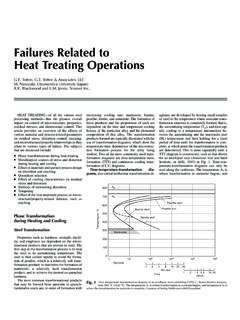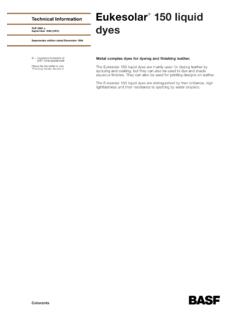Transcription of Residual Stresses, Distortion and Heat Transfer …
1 S nchez Sarmiento Residual stresses , Distortion and heat Transfer Coefficients of 7075 Aluminum Alloy Probes Quenched in Water and Polyalkylene glycol Solutions G. S nchez Sarmiento 1, D. M. Coscia 1, C. Jouglard 1, Totten 2, Webster 2 and J. Vega 3 1) Facultad de Ingenier a, Universidad de Buenos Aires, Buenos Aires, Argentina 2) Union Carbide Corporation, Tarrytown, New York. 3) SUDOSILO and Universidad Cat lica de C rdoba, C rdoba, Argentina. ABSTRACT A comparative study of Residual stresses and Distortion in cylindrical samples of Aluminum Alloy 7075-T6, quenched in aqueous solutions of PAG UCON A, with concentrations of 10, 20 and 30 % in water and under different conditions of agitation, is presented in this article. In order to discuss the comparative advantages of such aqueous solutions as quenching media with control of cracking and Distortion , the ABAQUS/Standard Finite Element Software was applied to assess such parameters during the heat treatment, with previous calculation of the heat Transfer coefficients as dependent of the temperature, by means of the INC-PHATRAN Code.
2 Based on the experimental cooling curves obtained by direct readings of thermocouples placed at the center of each sample, the INC-PHATRAN Code solved numerically the corresponding inverse heat conduction problem calculating the heat Transfer coefficients. Valuable conclusions about the use of PAG UCON A aqueous solutions, intended to minimize Distortion and cracking problems during heat treating, are the results of the present work. INTRODUCTION. In the field of heat treatment of metallic alloys, the importance of computer modelling is nowadays of vital importance. heat Transfer phenomena, coupled with solid phase transformations electromagnetic induction, diffusion of interstitial as well as substitutional solute elements through the lattice of the matrix phase, and the subsequent stress distribution and non-linear distortions, can be clearly understood by numerical simulation.
3 If computer modeling is combined with cooling curve experimental measurements, the result is a powerful and confident tool for the prediction of Distortion and Residual stresses in metallic components being processed by heat treatment. Among the several quenching media used in the alluminum industry, there should be mentioned mainly water, some types of oils and aqueous solutions of polymers. Aqueous solutions of Poly Alkylene glycol (PAG) are used to improve the cooling characteristics of the quenching medium and to reduce the machining requirements after the heat treatment PAG concentrations vary from 4 to 30 %, depending on the type of product being processed. For the heat treatment of aluminum alloys, such polymeric solutions have been widely applied during more than 30 years 1-4.
4 The present work consists of a comparative study of the distorsion and Residual stress distribution in cylindrical samples of Aluminum Alloy 7075-T6, quenched in aqueous solutions of PAG UCON A, with concentrations of 10, 20 and 30 % in water, with different rates of agitation. The samples used were of , , , and inches in diameter. S nchez Sarmiento Based on the experimental cooling curves obtained by direct readings of thermocouples placed at the center of each sample, a finite element computer simulation operation was carried out applying succesively the following two codes: a) Code INC-PHATRAN (INverse Conduction coupled with PHAse TRAN sformation) 5-11. This code is used to simulate a great variety of heat treatment processes in planar as well as in axisymmetric geometries.
5 With its application, the complete temperature distribution pattern throughout the full sample can be obtained. Once this is done and by means of an algorithm for numerical optimizing, an inverse heat conduction problem is solved, which consists on the calculation of heat Transfer coefficients that minimize the difference between the measured and calculated temperature distribution patterns. b) ABAQUS/Standard 12. This is a general purpose finite element an lisis code that was used, in this case, to simulate the Distortion and the Residual stresses produced in the studied samples, as a consequence of a heat treatment process, with previous calculation of the temperature distribution pattern in each case, based on the heat Transfer coefficients obtained with INC-PHATRAN.
6 A series of valuable conclusions about the use of PAG UCON A aqueous solutions, intended to minimize Distortion and cracking problems during heat treating, have been obtained , in accordance with previous quantitative results published in the literature4, comparing the aqueous solutions with pure water for this purpose. 2. INC-PHATRAN CODE. The INC-PHATRAN Code may be applied to simulate a great variety of heat treatment processes, in planar as well as axysimmetrical geometries. The corresponding heat Transfer coefficients can be calculated with its help, if cooling curves taken from different locations of the heat treated component are provided. The program has been presented at several international conferences 6-11 and is being used, at the present, for industrial applications in the USA, Colombia and Argentina.
7 The model is based on a numerical optimization algorithm which includes a module responsible for calculating on time and space the temperature distribution and its coupled microstructural evolution. In the present model, the transformation from austenite to ferrite and perlite is governed by the appropriate TTT curve and also by Avrami's approximation. Whereas the temperature distribution in a two dimension domain with axial symmetry is calculated using a finite element approximation, the time variation is approached using a Crank-Nicholson finite difference scheme. The temperature evolution, as measured by thermocouples at different positions in the component, are used as input for the program.
8 The program calculates the time variation of the heat Transfer coefficients, together with the temperature and distribution of phases, and their variation in time throughout the component. 3. EXPERIMENTAL PROCEDURE. Aluminum Alloy 7075 cylindrical samples of , and inches in diameter, with a length 4 times its diameter, were used to simulate infinite cylinders. They were quenched in aqueous polymer solutions with 10, 20 and 30 % of PAG UCON A, as well as in water, with and without agitation. The first three columns of Table 1 shows the quenchant, the size of the samples and the agitation rate of each of the samples identified in the column 4. Thermocuples were inserted in the center of each sample.
9 A specially prepared testing apparatus was used to control the PAG UCON A concentration, the temperature and the agitation rate. The thermocouples were connected to a computer to carry out the data adquisition process, with a known frequency. These curves were then kept in numerical files which were afterwards used to feed INC-PHATRAN Code. S nchez Sarmiento Experimental details about the measurement procedures as well as about the agitation and quenching devices, are described elsewhere (see refs. 1 and 3). heat Transfer coefficient [w/m2K] Quen-chant Sample diameter [inch Agita-tion [fpm] Probe identi-fication. 150 C 200 C 250 C 300 C350 C 400 C 450 C# 91 8978 14264 17705 17057 15910 11870349 25 # 92 8578 4045 14204 14803 14124 113311915 # 93 5147 10953 17895 22085 20110 126884788 Water 25 #94 5586 9815 18034 24738 28090 154811037 # 1 4048 6008 6040 5847 5398 4305 964 0 # 2 4337 6072 6811 6072 6297 4657 771 # 3 4947 6584 7681 6783 6483 4568 557 50 # 4 5306 6584 7561 6623 6304 4489 638 # 5 3148 5012 5815 5911 6072 4815 2249]
10 0 # 6 4149 5546 6065 5885 5727 5027 2294 # 7 4049 5686 6424 6085 5805 5007 2833 50 # 8 4329 5446 6424 6504 6085 4728 1775 # 9 4150 5885 5845 6284 7162 6224 2534 0 # 10 3232 4948 5466 6164 6843 6065 1995 # 11 4568 6085 6184 6483 6683 6364 2992 10% UCON A 50 # 12 3271 5386 6145 6045 6503 6583 3192 # 37 1975 3650 4219 4264 3650 2588 868 0 # 38 1990 3591 4294 4489 3980 2813 1047 # 39 1107 2603 3666 4219 4100 3546 1571 0 # 40 1810 3202 3890 4234 3920 3082 1062 # 41 ---- 2379 3561 4429 5087 4713 1945 20% UCON A 0 # 42 2050 3232 3845 4848 6005 4730 1780 # 55 997 2174 3002 3072 2314 1386 598 0 # 56 1177 2434 3092 3072 2394 1396 489 # 57 1337 2254 3042 3192 2663 1735 768 50 # 58 1317 2204 3102 3381 3022 2444 928 # 59 --- 1417 2264 2933








